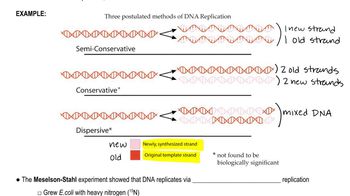Here are the essential concepts you must grasp in order to answer the question correctly.
Semiconservative Replication
Semiconservative replication is the process by which DNA makes copies of itself, where each new DNA molecule consists of one original strand and one newly synthesized strand. This model was proposed to explain how genetic information is accurately passed on during cell division, ensuring that each daughter cell receives an exact copy of the DNA.
Recommended video:
Semiconservative Replication
Meselson-Stahl Experiment
The Meselson-Stahl experiment utilized isotopes of nitrogen to label DNA in bacteria. By growing E. coli in a medium containing heavy nitrogen (N-15) and then transferring them to a medium with light nitrogen (N-14), they analyzed the density of the DNA after one and two replication cycles. The results showed that after one cycle, the DNA had an intermediate density, and after two cycles, there were both light and intermediate density DNA, supporting the semiconservative model.
Recommended video:
Exclusion of Alternative Models
The alternative models of DNA replication included conservative and dispersive replication. The conservative model suggested that the original DNA strands remained together, while the dispersive model proposed that parental and new DNA would be interspersed. The results of the Meselson-Stahl experiment, showing distinct bands of DNA density, effectively excluded these models, as they could not account for the observed intermediate density after one replication cycle.
Recommended video:
 Verified step by step guidance
Verified step by step guidance Verified video answer for a similar problem:
Verified video answer for a similar problem:



 14:31m
14:31m